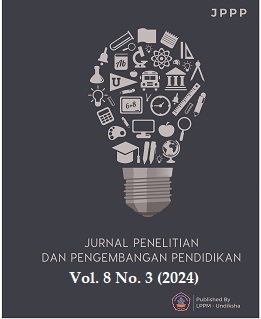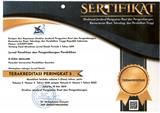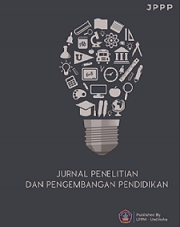Sparkol Videoscribe Learning Media for Science Subjects on Human Needs Material
DOI:
https://doi.org/10.23887/jppp.v8i3.80114Keywords:
Learning Media, Sparkol Videoscribe, IPASAbstract
The most prominent problem in learning Natural and Social Sciences (IPAS) is the less-than-optimal use of learning media, which affects students' learning outcomes. This development research aims to develop Sparkol Videoscribe media on IPAS on human needs material. This type of research is development research. This research applies the ADDIE development model. The research subjects are 1 learning media expert and 1 learning material expert. The subjects of this development research trial are 18 students and grade IV teachers. Data collection techniques are done through interviews, observations, tests, questionnaires and documentation. The data collection instrument uses questions to test the feasibility of the Sparkol videoscribe media. The techniques used to analyze the data are qualitative, quantitative, descriptive analysis, and inferential statistics. The study results showed that Sparkol videoscribe is feasible to use, based on the assessment of media experts by 95.8% and material experts by 90% with very feasible criteria. The media developed is practical based on the t-test and n-gain test with moderate criteria. It is concluded that the Sparkol videoscribe learning media that has been developed is feasible and effective to use in IPAS learning because it can improve students' learning outcomes. The implications of the research are that the Sparkol Videoscribe media developed for science subjects can be used in learning.
References
Adnyana, K. S., & Yudaparmita, G. N. A. (2023). Peningkatan Minat Belajar IPAS Berbantuan Media Gambar Pada Siswa Sekolah Dasar. Edukasi: Jurnal Pendidikan Dasar, 4(1), 61. https://doi.org/10.55115/edukasi.v4i1.3023.
Afridoni, A., Putra, S., Hasri, S., & Sohiron, S. (2022). Manajemen Akreditasi Sekolah Upaya Peningkatan Mutu Pendidikan. Jurnal Pendidikan Tambusai, 6(3). https://doi.org/10.31004/jptam.v6i3.4402.
Andriani, F., & Wahyudi, W. (2023). Media Permainan Ular Tangga Berbasis Misi Untuk Meningkatkan Kemampuan Pemecahan Masalah Matematika Siswa SD. Jurnal Educatio, 9(4), 1869–1875. https://doi.org/10.31949/educatio.v9i4.5743.
Anggraeni, N. O., Abidin, Y., & Wahyuningsih, Y. (2023). Pengembangan Media Pembelajaran Permainan Ular Tangga Digital Pada Materi Keragaman Budaya Indonesia Mata Pelajaran Ips Kelas Iv Sekolah Dasar. Jurnal PIPSI (Jurnal Pendidikan IPS Indonesia), 8(1), 22. https://doi.org/10.26737/jpipsi.v8i1.3976.
Ariani, N. K., & Ujianti, P. R. (2021). Media Video Animasi untuk Meningkatkan Listening Skill Anak Usia Dini. Jurnal Pendidikan Anak Usia Dini Undiksha, 9(1), 43. https://doi.org/10.23887/paud.v9i1.35690.
Ayu Tantri, D., Agung Gede Agung, A., & Wayan Ilia Yuda Sukmana, A. I. (2023). Media Video Pembelajaran pada Mata Pelajaran Bahasa Indonesia Kelas V. Mimbar PGSD Undiksha, 11(1), 100–109. https://doi.org/10.23887/jjpgsd.v11i1.57719.
Budiwati, R., Budiarti, A., Muckromin, A., Hidayati, Y. M., & Desstya, A. (2023). Analisis Buku IPAS Kelas IV Kurikulum Merdeka Ditinjau dari Miskonsepsi. Jurnal Basicedu, 7(1), 523–534. https://doi.org/10.31004/basicedu.v7i1.4566.
Cahyani, N. L. aParamita, & Jayanta, I. N. L. (2021). Digital Literacy-Based Learning Video on the Topic of Natural Resources and Technology for Grade IV Elementary School. Jurnal Ilmiah Sekolah Dasar, 5(3), 538. https://doi.org/10.23887/jisd.v5i3.37918.
Dafitri, R. S., Hasrul, H., Rafni, A., & Bakhtiar, Y. (2022). Implementasi Program Merdeka Belajar melalui Profil Pelajar Pancasila di SMKN 1 Sijunjung. Journal of Education, Cultural and Politics, 2(2), 175–184. https://doi.org/10.24036/jecco.v2i2.65.
Darmawan, D., & Wahyudi, W. (2023). Pengembangan Media Game Ular Tangga Berbasis Produk BARUNG untuk Meningkatkan Kreativitas Peserta Didik Sekolah Dasar. JIIP - Jurnal Ilmiah Ilmu Pendidikan, 6(12), 10723–10729. https://doi.org/10.54371/jiip.v6i12.3420.
Fadillah, A., & Bilda, W. (2019). Pengembangan Video Pembelajaran Berbantuan Aplikasi Sparkoll Videoscribe. Jurnal Gantang, 4(2). https://doi.org/10.31629/jg.v4i2.1369.
Failasufah, M., & Setyasto, N. (2023). Audio-Assisted Smartbox Learning Media in IPAS Content of Metamorphosis of Animals for Fourth-Grade Students. Jurnal Penelitian dan Pengembangan Pendidikan, 7(3), 456–464. https://doi.org/10.23887/jppp.v7i3.65677.
Faizi, A. N., Fauziya, D. S., & Azzahra, I. S. S. (2022). Pembelajaran Menulis Teks Prosedur pada Siswa Kelas XI SMA dengan Metode Discovery Learning Berbantuan Aplikasi Sparkol. Parole: Jurnal Pendidikan Bahasa dan Sastra Indonesia, 5(2), 161–172. https://doi.org/10.22460/parole.v5i2.11197.
Fanani, A., Rosidah, C. T., Juniarso, T., Roys, G. A., Putri, E. S., & Vannilia, V. (2022). Bahan Ajar Digital Berbasis Multiaplikasi Mata Pelajaran IPAS SD. Jurnal Pembelajaran, Bimbingan, dan Pengelolaan Pendidikan, 2(12), 1175–118. https://doi.org/10.17977/um065v2i122022p1175-118.
Febrian, F., Astuti, P., & Antika, R. (2019). Pelatihan Pengembangan Media Videoscribe dengan Konteks Lokal dalam Mengajarkan Objek Matematika bagi MGMPSMAKabupaten Bintan. J-ABDIPAMAS (Jurnal Pengabdian Kepada Masyarakat), 3(2), 101. https://doi.org/10.30734/j-abdipamas.v3i2.634.
Firdaus, F., Haerul Pathoni, & Alrizal, A. (2023). Analisis Kebutuhan Peserta Didik terhadap Media Pembelajaran Sebagai Acuan Pengembangan Video Pembelajaran Berbasis Pendekatan STEM pada Materi Pengukuran. Jurnal Pendidikan Mipa, 13(3), 790–796. https://doi.org/10.37630/jpm.v13i3.1006.
Fitri, F., & Ardipal, A. (2021). Pengembangan Video Pembelajaran Menggunakan Aplikasi Kinemaster pada Pembelajaran Tematik di Sekolah Dasar. Jurnal Basicedu, 5(6), 6330–6338. https://doi.org/10.31004/basicedu.v5i6.1387.
Fransisca, I., & Mintohari. (2018). Pengembangan Media Pembelajaran Video Berbasis Sparkol Videoscribe Pada Pelajaran IPA dalam Materi Tata Surya Kelas VI SD. Jurnal Penelitian Pendidikan Guru Sekolah Dasar, 6(11), 1916–1927.
Gae, N. A., Ganing, N. N., & Kristiantari, M. G. (2021). Pengembangan Media Video Animasi Berorientasi Membaca Pemahaman dengan Strategi Directed Reading Thinking Activity (DRTA) pada Muatan Bahasa Indonesia. Jurnal Penelitian & Pengembangan Pendidikan, 5(1). https://doi.org/10.23887/jppp.v5i1.32453.
Hanif, M. (2020). The development and effectiveness of motion graphic animation videos to improve primary school students’ sciences learning outcomes. International Journal of Instruction, 13(4), 247–266. https://doi.org/10.29333/iji.2020.13416a.
Hasan, A. A., & Baroroh, U. (2019). Pengembangan Media Pembelajaran Bahasa Arab Melalui Aplikasi Videoscribe Dalam Meningkatkan Motivasi Belajar Siswa. Lisanuna: Jurnal Ilmu Bahasa Arab Dan Pembelajarannya, 9(2). https://doi.org/10.22373/ls.v9i2.6738.
Heryandi, Y., & Nur`aini, N. (2022). Pengaruh Penggunaan Media Video Pembelajaran Untuk Mereduksi Miskonsepsi Matematika Siswa. Integral : Pendidikan Matematika, 13(1), 13–25. https://doi.org/10.32534/jnr.v13i1.3108.
Ilsa, A., F, F., & Harun, M. (2020). Pengembangan Video Pembelajaran dengan Menggunakan Aplikasi Powerdirector 18 di Sekolah Dasar. Jurnal Basicedu, 5(1), 288–300. https://doi.org/10.31004/basicedu.v5i1.643.
Imah, R., Rochmiyati, S., & Yuniharto, B. S. (2022). Telaah Nilai Gotong Royong pada Fabel untuk Pendidikan Karakter di Sekolah Dasar. Edukasi: Jurnal Penelitian Dan Artikel Pendidikan, 14(1), 69–84. https://doi.org/10.31603/edukasi.v14i1.7164.
Jonnalagadda, R., Singh, P., Gogineni, A., Reddy, R. R. S., & Reddy, H. B. (2022). Developing, Implementing and Evaluating Training for Online Graduate Teaching Assistants Based on ADDIE Model. Asian Journal of Education and Social Studies, 28(1), 1–10. https://doi.org/10.9734/ajess/2022/v28i130664.
Juniarsih, W., Maftuhah, Y., & Syamsiyah, S. (2021). Peningkatan Motivasi Belajar Matematika Simetri Lipat Dan Simetri Putar Melalui Media Sparkol. Educatif Journal of Education Research, 4(1), 8–17. https://doi.org/10.36654/educatif.v4i1.87.
Karisma, I. K. E., Margunayasa, I. G., & Prasasti, P. A. T. (2020). Pengembangan Media Pop-Up Book pada Topik Perkembangbiakan Tumbuhan dan Hewan Kelas VI Sekolah Dasar. Jurnal Ilmiah Sekolah Dasar, 4(2), 121. https://doi.org/10.23887/jisd.v4i2.24458.
Khairani, A., & Ain, S. Q. (2021). Pengembangan Media Pembelajaran Video Menggunakan Sparkol Videoscribe Pada Materi Statistika Kelas IV SD. QALAMUNA: Jurnal Pendidikan, Sosial, dan Agama, 13(2), 219–238. https://doi.org/10.37680/qalamuna.v13i2.898.
Latifah, N., Hasan, N., & Fitria, Y. A. (2020). Pengembangan Media Pembelajaran Sparkol Videoscribe Terhadap Keterampilan Menulis Siswa Kelas Vi Sekolah Dasar Negri Sukamurni 1 Kabupaten Tengerang. Jurnal Madrasah Ibtidaiyah, 6(1), 40–48. https://doi.org/10.31602/muallimuna.v6i1.3463.
Lia, L. K. A., Atikah, C., & Nulhakim, L. (2023). Pengembangan Media Pembelajaran Video Animasi Berbasis Animaker Untuk Meningkatkan Hasil Belajar Siswa Sd. Jurnal Ilmiah Pendidikan Citra Bakti, 10(2), 386–400. https://doi.org/10.38048/jipcb.v10i2.1634.
Marwa. (2023). Persepsi Guru Sekolah Dasar Terhadap Mata Pelajaran IPAS Pada Kurukulum Merdeka. Metodik Didaktik: Jurnal Pendidikan Ke-SD-an, 18(2), 54–65. https://doi.org/10.17509/md.v18i2.53304.
Maulidah, A. N., & Aslam, A. A. (2021). Penggunaan Media Puzzle secara Daring terhadap Hasil Belajar IPA Kelas V SD. Mimbar Ilmu, 26(2), 281. https://doi.org/10.23887/mi.v26i2.37488.
Muhardini, S., Haifaturrahmah, H., Sudarwo, R., Kartiani, B. S., Anam, K., Mahsup, M., Khosiah, K., Ibrahim, I., & Herianto, A. (2023). Pengembangan Modul Ajar Ilmu Pengetahuan Alam Dan Sosial (Ipas) Bagi Siswa Sekolah Dasar Kelas Iv Dalam Kerangka Kurikulum Merdeka. ORBITA: Jurnal Kajian, Inovasi, dan Aplikasi Pendidikan Fisika, 9(1). https://doi.org/10.31764/orbita.v9i1.14742.
Nabela, D., Kasiyun, S., Rahayu, D. W., & Akhwani, A. (2021). Analisis Gaya Belajar Peserta Didik Berprestasi selama Pandemi Covid-19 dalam Pembelajaran Tematik di Sekolah Dasar. Jurnal Basicedu, 5(4), 2653–2663. https://doi.org/10.31004/basicedu.v5i4.1301.
Nafisah, F. V., & Pramudiani, P. (2023). Pengaruh Penggunaan Sparkol Videoscribe terhadap Motivasi Belajar Matematika Materi Pecahan pada Siswa Sekolah Dasar. Jurnal Cendekia : Jurnal Pendidikan Matematika, 7(1), 695–702. https://doi.org/10.31004/cendekia.v7i1.1483.
Novita, L., Sukmanasa, E., & Pratama, M. Y. (2019). Penggunaan Media Pembelajaran Video terhadap Hasil Belajar Siswa SD. Indonesian Journal of Primary Education, 3(2), 64–72. https://doi.org/10.17509/ijpe.v3i2.22103.
Nur Jannah, I. (2020). Efektivitas Penggunaan Multimedia dalam Pembelajaran IPA di SD. Jurnal Ilmiah Sekolah Dasar, 4(1), 54. https://doi.org/10.23887/jisd.v4i1.24135.
Nurfadhillah, S., Cahyani, A. P., Haya, A. F., Ananda, P. S., Widyastuti, T., & Tangerang, U. M. (2021). Penerapan Media Audio Visual Berbasis Video Pembelajaran Pada Siswa Kelas IV Di SDN Cengklong 3. Jurnal Pendidikan dan Dakwah, 3(2), 396–418. https://doi.org/10.36088/pandawa.v3i2.1272.
Nurrohmah, F., Putra, F. G., & Farida, F. (2018). Development of Sparkol Video Scribe Assisted Learning Media. Formatif: Jurnal Ilmiah Pendidikan MIPA, 8(3), 233–250. https://doi.org/10.30998/formatif.v8i3.2613.
Octavyanti, N. P. L., & Wulandari, I. G. A. A. (2021). Pengembangan Video Pembelajaran Berbasis Pendekatan Kontekstual Pada Mata Pelajaran Matematika Kelas IV SD. Jurnal Edutech Undiksha, 9(1), 66–74. https://doi.org/10.23887/jeu.v9i1.32223.
Pamungkas, A. S., Ihsanudin, I., Novaliyosi, N., & Yandari, I. A. V. (2018). Video Pembelajaran Berbasis Sparkol Videoscribe: Inovasi Pada Perkuliahan Sejarah Matematika. Prima: Jurnal Pendidikan Matematika, 2(2), 127. https://doi.org/10.31000/prima.v2i2.705.
Panggabean, F., Simanjuntak, M. P., Florenza, M., Sinaga, L., & Rahmadani, S. (2021). Analisis Peran Media Video Pembelajaran dalam Meningkatkan Hasil Belajar IPA SMP. Jurnal Pendidikan Pembelajaran IPA Indonesia (JPPIPA), 2(1), 7–12. https://doi.org/10.37148/bios.v1i1.3.
Peña-Ayala, A. (2021). A learning design cooperative framework to instill 21st century education. Telematics and Informatics, 62(May). https://doi.org/10.1016/j.tele.2021.101632.
Prasetya, W. A., Suwatra, I. I. W., & Mahadewi, L. P. P. (2021). Pengembangan Video Animasi Pembelajaran Pada Mata Pelajaran Matematika. Jurnal Penelitian dan Pengembangan Pendidikan, 5(1), 60–68. https://doi.org/10.23887/jppp.v5i1.32509.
Pratiwi, A., Islami, N., & Pekanbaru, U. R. (2023). Pengaruh Penerapan Model Pembelajaran Kooperatif Menggunakan Sparkol Videoscribe pada Materi Fluida Statis terhadap Hasil Belajar Siswa Kelas XI SMA Negeri 1 Teluk Sebong. Jurnal Pendidikan Tambusai, 7(1), 427–432.
Prehanto, A., Aprily, N. M., Merliana, A., & Nurhazanah, M. (2021). Video Pembelajaran Interaktif-Animatif sebagai Media Pembelajaran IPS SD Kelas Tinggi di Masa Pandemi Covid 19. Indonesian Journal of Primary Education, 5(1), 32–38. https://doi.org/10.17509/ijpe.v5i1.33696.
Rahayu, M., & Masniladevi, M. (2020). Pengaruh Penggunaan Media Sparkol Videoscribe terhadap Komunikasi Matematis Materi Faktor Dan Kelipatan Bilangan Kelas IV SDN 04 Pasar Surantih. Jurnal Pendidikan Tambusai, 4, 2239–2249.
Rahmawati, F., & Atmojo, I. R. W. (2021). Analisis Media Digital Video Pembelajaran Abad 21 Menggunakan Aplikasi Canva Pada Pembelajaran IPA. Jurnal Basicedu, 5(6), 6271–6279. https://doi.org/10.31004/basicedu.v5i6.1717.
Rasyid, H., & Islamia, I. N. (2021). Pengaruh media audio visual (video) terhadap motivasi belajar dalam pembelajaran ips smp/mts di kecamatan tajinan. SANDHYAKALA Jurnal Pendidikan Sejarah, Sosial Dan Budaya, 2(2), 77–86. https://doi.org/10.31537/sandhyakala.v2i2.568.
Ridha, M., Firman, & Desyandri. (2021). Efektifitas Penggunaan Media Video pada Pembelajaran Tematik Terpadu di Sekolah Dasar Saat Pandemi Covid-19. Jurnal Pendidikan Tambusai, 5(1), 154–162. https://doi.org/10.31004/jptam.v5i1.925.
Rosyita, M., & Tsurayya, A. (2021). Pengembangan Video Pembelajaran Matematika Materi Peluang Berbasis Sparkol Videoscribe untuk Meningkatkan Kemampuan Pemahaman Konsep Matematika Siswa Kelas VIII SMP/MTs. Jurnal Cendekia : Jurnal Pendidikan Matematika, 5(3), 3136–3147. https://doi.org/10.31004/cendekia.v5i3.954.
Sa’adahh. (2023). Analisis Faktor Penyebab Kesulitan Belajar Siswa Kelas IV SD pada Mata Pelajaran IPAS dalam Kurikulum Merdeka. el-Ibtidaiy: Journal of Primary Education, 6(2), 209–216. https://doi.org/10.24014/ejpe.v6i2.23939.
Saadah, N., Robandi, B., Rosmiati, I., & Maulana, Y. (2022). Analisis Pedagogical Content Knowledge terhadap Buku Guru IPAS pada Muatan IPA Sekolah Dasar Kurikulum Merdeka. Jurnal Basicedu, 6(5). https://doi.org/10.31004/basicedu.v6i5.3662
Santagata, R., König, J., Scheiner, T., Nguyen, H., Adleff, A. K., Yang, X., & Kaiser, G. (2021). Mathematics teacher learning to notice: a systematic review of studies of video-based programs. ZDM - Mathematics Education, 53(1), 119–134. https://doi.org/10.1007/s11858-020-01216-z.
Santoso, G., Damayanti, A., Murod, M., & Imawati, S. (2023). Implementasi Kurikulum Merdeka melalui Literasi Proyek Penguatan Profil Pelajar Pancasila. Jurnal Pendidikan Transformatif (Jupetra), 02(01), 84–89. https://doi.org/10.9000/jupetra.v2i1.127.
Saragi, R., & Tegeh, I. M. (2022). Media Pembelajaran Berbasis Problem Based Learnig Menggunakan VideoScribe untuk Meningkatkan Hasil Belajar IPS Siswa Kelas V. Jurnal Edutech Undiksha, 10(1), 98–107. https://doi.org/10.23887/jeu.v10i1.41538.
Silvia, A. D., Roshayanti, F., & Ayu, N. (2023). Pengaruh Model Pembelajaran Problem Based Learning Terhadap Hasil Belajar Ipas Siswa Kelas Iv Sd Negeri Gayamsari 02. Didaktik : Jurnal Ilmiah PGSD STKIP Subang, 9(2), 4362–4370. https://doi.org/10.36989/didaktik.v9i2.1106.
Siregar, L., & Al-washliyah, U. M. N. (2022). Pengembangan Media Video Animasi Berbasis Sparkol Videoscribe Pada Pembelajaran IPS Di SD. Jurnal Pusat Studi Pendidikan Rakyat, 2, 11–21.
Sukarini, K., & Manuaba, I. B. S. (2021). Video animasi pembelajaran daring pada mata pelajaran IPA kelas VI Sekolah Dasar. Jurnal Edutech Undiksha, 9(1), 48–56. https://doi.org/10.23887/jeu.v9i1.32347.
Surya, A. D., Sumarno, S., & Muhtarom, M. (2023). Analisis Kualitas Instrumen Tes Hasil Belajar IPAS Materi Wujud Zat dan Perubahannya. Fondatia : Jurnal Pendidikan Dasar, 7(2). https://doi.org/10.36088/fondatia.v7i2.3190.
Widiyasanti, M., & Ayriza, Y. (2018). Pengembangan Media Video Animasi untuk Meningkatkan Motivasi Belajar dan Karakter Tanggung Jawab Siswa Kelas V. Jurnal Pendidikan Karakter, 8(1), 1–16. https://doi.org/10.21831/jpk.v8i1.21489.
Wijayanti. (2023). Implementasi Kurikulum Merdeka pada Pembelajaran IPAS MI/SD. Pendas: Jurnal Ilmiah Pendidikan Dasar, 8(2), 2100–2112. https://doi.org/10.23969/jp.v8i2.9597.
Wulandari, I. G. A. A. M., Sudatha, I. G. W., & Simamora, A. H. (2020). Pengembangan Pembelajaran Blended Pada Mata Kuliah Ahara Yoga Semester II di IHDN Denpasar. Jurnal Edutech Undiksha, 8(1), 1. https://doi.org/10.23887/jeu.v8i1.26459.
Yanto, N., Muliana, & Zubair, S. (2023). The Effect of Pop Up Book Media in Science Learning: A Literature Review. Journal of Education and Learning Innovation, 3(2), 2775–6173. https://doi.org/10.35877/454RI.eduline1772.
Yuniarti, N. P. M., & Trisna, G. A. P. S. (2022). Efektivitas Media Pembelajaran Videoscribe Connected terhadap Minat Belajar Siswa. Jurnal Pedagogi dan Pembelajaran, 5(1), 160–171. https://doi.org/10.23887/jp2.v5i1.47009.
Zulmiyetri, Z., Kasiyati, K., & Kusumastuti, G. (2019). Improving Reading Fluency Through Videoscribe For Student with Learning Disability. International Journal of Research in Counseling and Education, 3(2), 76. https://doi.org/10.24036/0056za0002.
Downloads
Published
How to Cite
Issue
Section
License
Copyright (c) 2024 Amalia Nurusyifa, Desi Wulandari

This work is licensed under a Creative Commons Attribution-ShareAlike 4.0 International License.
Authors who publish with the Jurnal Penelitian dan Pengembangan Pendidikan agree to the following terms:
- Authors retain copyright and grant the journal the right of first publication with the work simultaneously licensed under a Creative Commons Attribution License (CC BY-SA 4.0) that allows others to share the work with an acknowledgment of the work's authorship and initial publication in this journal.
- Authors are able to enter into separate, additional contractual arrangements for the non-exclusive distribution of the journal's published version of the work (e.g., post it to an institutional repository or publish it in a book), with an acknowledgment of its initial publication in this journal.
- Authors are permitted and encouraged to post their work online (e.g., in institutional repositories or on their website) prior to and during the submission process, as it can lead to productive exchanges, as well as earlier and greater citation of published work. (See The Effect of Open Access)








